Child Labour and Ragged Schools: A Discourse Analysis of Childhood
VerifiedAdded on 2023/06/13
|78
|23849
|223
Essay
AI Summary
This essay delves into the various discourses of childhood in Victorian London, contrasting the romantic ideal with the harsh realities of factory labor. It examines how children were forced into work, leading to the emergence of delinquent and psycho-medical child figures. The essay highlights the role of ragged schools in providing free elementary education to these children, aiming to transform them into schooled and evangelical individuals. Drawing upon sources from the British Library, including articles on child labour and ragged schools, the analysis explores the experiences of children in mines and factories, their exploitation, and the impact on their physical and mental well-being. The essay also discusses how ragged schools offered a glimmer of hope by providing education, fostering positive behavioral changes, and ultimately contributing to the development of a more organized elementary education system. It concludes by emphasizing the need for global efforts to eliminate child labour and provide education to affected children, potentially following the ragged school model.
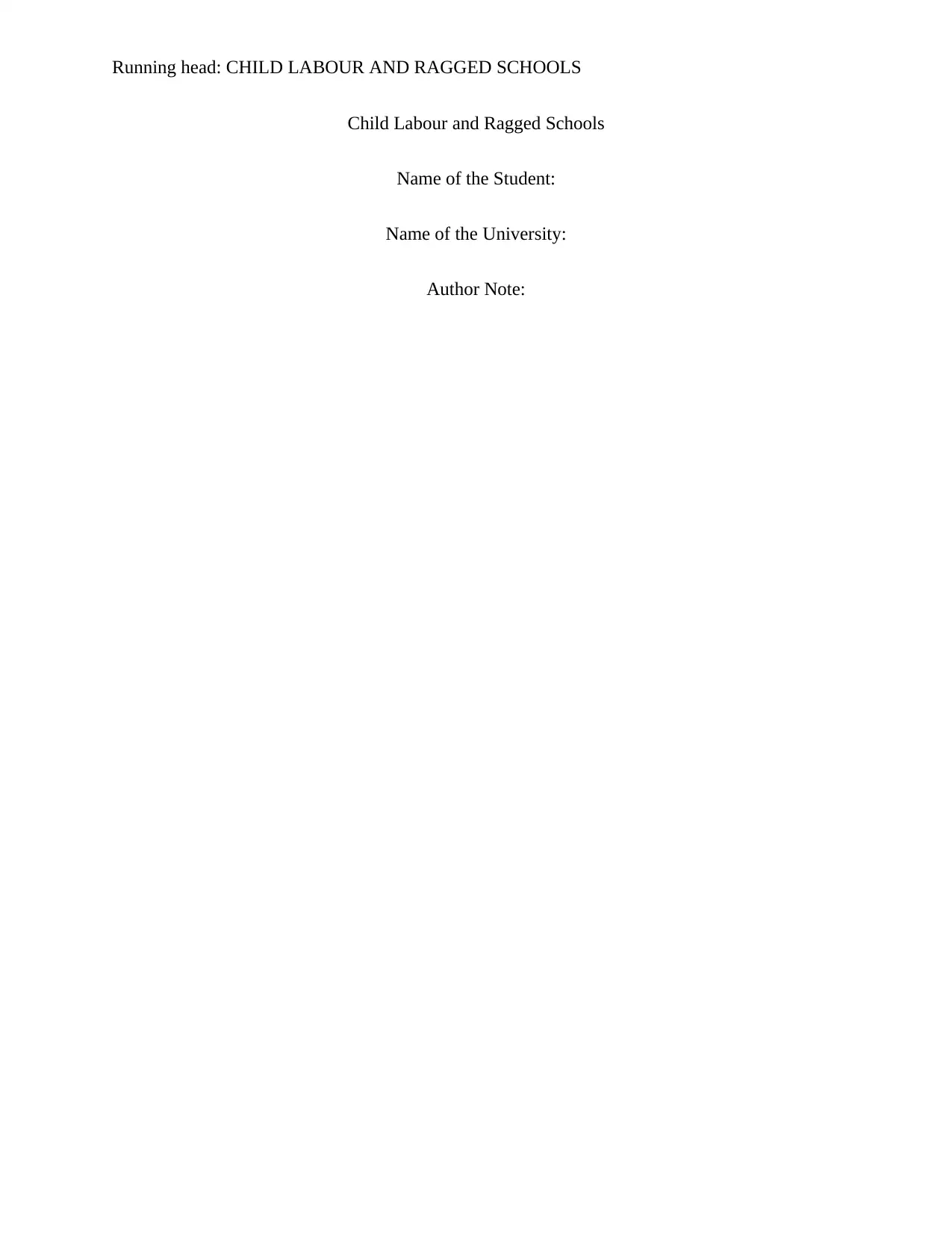
Running head: CHILD LABOUR AND RAGGED SCHOOLS
Child Labour and Ragged Schools
Name of the Student:
Name of the University:
Author Note:
Child Labour and Ragged Schools
Name of the Student:
Name of the University:
Author Note:
Paraphrase This Document
Need a fresh take? Get an instant paraphrase of this document with our AI Paraphraser

1
CHILD LABOUR AND RAGGED SCHOOLS
The essay would delve into different discourses of childhood with reference to Victorian
London like romantic child, factory child and the schooled child. The scholars like Rousseau
stressed on the needs of the romantic period in the lives of children. However, in the poor
families, the children were often forced to work and the romantic child faded into the factory
children. The oppression of child labour often gave birth to delinquent child and the psycho-
medical child. The ragged schools evolved in England around the 18th century to provide
elementary and free education to these children. They to a certain extent succeeded in creating
schooled child out of the oppressed and the psychologically tortured child (bl.uk 2018). The
essay would delve into these stages of the various forms of the poor children thriving in
Victorian London.
The first document on child labour is an article from the British Library which
sketches a picture of 19th century Victorian London (Appendix 1). Rousseau proposed the
concept that children have individuality and have the right to enjoy their childhood. This phase
of a phase child’s life came to be termed as romantic childhood was often interrupted by social
issues like child labour. The use of children to do dangerous work in factories devastated their
romantic children and turned them into factory children. The practice of employing child most
probably started with the advancement of the manufacturing industries which used machines for
mass production. The owners of these factories usually recruited children to do jobs like picking
coal, cleaning machines and helping workers by reaching out their tools for them. The spread of
industrialisation around the cities required more children to be employed in the factories. This
led to a large population of child labour in the cities. The scenario in the rural areas were much
better, at least the children started working at a little stage of their lives. They did works like
sowing seeds in the fields, scaring off birds from crops and riding horses. Child labour,
CHILD LABOUR AND RAGGED SCHOOLS
The essay would delve into different discourses of childhood with reference to Victorian
London like romantic child, factory child and the schooled child. The scholars like Rousseau
stressed on the needs of the romantic period in the lives of children. However, in the poor
families, the children were often forced to work and the romantic child faded into the factory
children. The oppression of child labour often gave birth to delinquent child and the psycho-
medical child. The ragged schools evolved in England around the 18th century to provide
elementary and free education to these children. They to a certain extent succeeded in creating
schooled child out of the oppressed and the psychologically tortured child (bl.uk 2018). The
essay would delve into these stages of the various forms of the poor children thriving in
Victorian London.
The first document on child labour is an article from the British Library which
sketches a picture of 19th century Victorian London (Appendix 1). Rousseau proposed the
concept that children have individuality and have the right to enjoy their childhood. This phase
of a phase child’s life came to be termed as romantic childhood was often interrupted by social
issues like child labour. The use of children to do dangerous work in factories devastated their
romantic children and turned them into factory children. The practice of employing child most
probably started with the advancement of the manufacturing industries which used machines for
mass production. The owners of these factories usually recruited children to do jobs like picking
coal, cleaning machines and helping workers by reaching out their tools for them. The spread of
industrialisation around the cities required more children to be employed in the factories. This
led to a large population of child labour in the cities. The scenario in the rural areas were much
better, at least the children started working at a little stage of their lives. They did works like
sowing seeds in the fields, scaring off birds from crops and riding horses. Child labour,

2
CHILD LABOUR AND RAGGED SCHOOLS
irrespective of industry and region of employment had a very devastating effect on their
development (Sanghera 2017).
Child labour had a very painful impact on the mind, lives, growth and development
of the children which even scarred their future. The employers exploited the children by
making them work for long hours, longer than the elder workers. They were had to work under
machines and in the mines, all of which were dangerous. According to Kiss et al. (2015), in
additional to gruelling hours of exploitation, these children were paid far less compared to the
senior workers and were exploited physically. They were not given enough food and were beaten
up. The employers often chose the youngest children to work in their factories. The dangerous
working conditions in which children were made to work like mines were responsible for
accidents. Children working in the queries often suffered cuts, burns, fractures, dizziness and
breathing problem, some of which were severe and led to permanent damage to the children
caught in the accidents. The exploitation of the factory owners led deep mark on the minds of the
children and they suffered from nightmares and abnormal and inexplicable fear. The children
often faced rejected from their family and friends. They usually faced painful remarks which
pushed them into social alienation and depression, thus damaging them psychology altogether.
They had to compete with the adult workers who worked for shorter hours and at comparatively
higher salary. It can be summarised that these painful experiences of physical and mental
exploitation in these psycho-medical children caught in the maze of child labour was worsened
by lack of education (ilo.org 2018).
The children in London caught in child labour were deprived of education which
marred their future, worsening their painful life experiences. The children working in the
mines were deprived of education because they could not attend school. This impaired their
CHILD LABOUR AND RAGGED SCHOOLS
irrespective of industry and region of employment had a very devastating effect on their
development (Sanghera 2017).
Child labour had a very painful impact on the mind, lives, growth and development
of the children which even scarred their future. The employers exploited the children by
making them work for long hours, longer than the elder workers. They were had to work under
machines and in the mines, all of which were dangerous. According to Kiss et al. (2015), in
additional to gruelling hours of exploitation, these children were paid far less compared to the
senior workers and were exploited physically. They were not given enough food and were beaten
up. The employers often chose the youngest children to work in their factories. The dangerous
working conditions in which children were made to work like mines were responsible for
accidents. Children working in the queries often suffered cuts, burns, fractures, dizziness and
breathing problem, some of which were severe and led to permanent damage to the children
caught in the accidents. The exploitation of the factory owners led deep mark on the minds of the
children and they suffered from nightmares and abnormal and inexplicable fear. The children
often faced rejected from their family and friends. They usually faced painful remarks which
pushed them into social alienation and depression, thus damaging them psychology altogether.
They had to compete with the adult workers who worked for shorter hours and at comparatively
higher salary. It can be summarised that these painful experiences of physical and mental
exploitation in these psycho-medical children caught in the maze of child labour was worsened
by lack of education (ilo.org 2018).
The children in London caught in child labour were deprived of education which
marred their future, worsening their painful life experiences. The children working in the
mines were deprived of education because they could not attend school. This impaired their
⊘ This is a preview!⊘
Do you want full access?
Subscribe today to unlock all pages.

Trusted by 1+ million students worldwide

3
CHILD LABOUR AND RAGGED SCHOOLS
ability to acquire well paid jobs and lead a respectable life. This fear of their future being
doomed created further depression and insecurity. A report by the National Bureau of Economic
Research, the United States of America points out that access to sharp tools coupled with the
inhuman treatment which children trapped in child labour receive lead to arousal of criminal
mentality, thus giving birth to the delinquent children (nber.org 2018). There have also been
reports that these children took up activities like thieving to earn their living. These poor and
suffering children were given education in the ragged schools, which was perhaps the only gleam
of hope in these painful lives (Fontana and Grugel 2015).
The second article from the British Library deals about a brighter form of the
delinquent and the psycho-medical children, the evangelical child (Appendix 2). The ragged
schools were usually free schools which provided education to the destitute children. These
schools were charitable organisations which were run by churches and tried to create evangelical
children out of the delinquent factory children (nationalarchives.gov.uk 2018). The teachers who
imparted education to these children were usually local people without any formal training
though some were employed. The subjects which the unfortunate children learnt were arithmetic,
reading, writing and education on the Holy Bible. These schools also included some basic
lessons on machine operating which was a sort of technical education the children labouring the
industries received. The venue for these ragged schools were often streets and railway arches.
Many of these schools were held at night to allow the children work during the day (Bandara,
Dehejia and Lavie-Rouse 2015).
Education is shown to have positive and strengthening impact on child development.
The child labour receiving education in the ragged school started showing positive
behavioural and cognitive skills, thus enhancing their social acceptances. This in turn
CHILD LABOUR AND RAGGED SCHOOLS
ability to acquire well paid jobs and lead a respectable life. This fear of their future being
doomed created further depression and insecurity. A report by the National Bureau of Economic
Research, the United States of America points out that access to sharp tools coupled with the
inhuman treatment which children trapped in child labour receive lead to arousal of criminal
mentality, thus giving birth to the delinquent children (nber.org 2018). There have also been
reports that these children took up activities like thieving to earn their living. These poor and
suffering children were given education in the ragged schools, which was perhaps the only gleam
of hope in these painful lives (Fontana and Grugel 2015).
The second article from the British Library deals about a brighter form of the
delinquent and the psycho-medical children, the evangelical child (Appendix 2). The ragged
schools were usually free schools which provided education to the destitute children. These
schools were charitable organisations which were run by churches and tried to create evangelical
children out of the delinquent factory children (nationalarchives.gov.uk 2018). The teachers who
imparted education to these children were usually local people without any formal training
though some were employed. The subjects which the unfortunate children learnt were arithmetic,
reading, writing and education on the Holy Bible. These schools also included some basic
lessons on machine operating which was a sort of technical education the children labouring the
industries received. The venue for these ragged schools were often streets and railway arches.
Many of these schools were held at night to allow the children work during the day (Bandara,
Dehejia and Lavie-Rouse 2015).
Education is shown to have positive and strengthening impact on child development.
The child labour receiving education in the ragged school started showing positive
behavioural and cognitive skills, thus enhancing their social acceptances. This in turn
Paraphrase This Document
Need a fresh take? Get an instant paraphrase of this document with our AI Paraphraser

4
CHILD LABOUR AND RAGGED SCHOOLS
resulted in fall of crime and better performances in the jobs. These benefits of child education
which ragged school ushered into nineteenth century London led to founding of more ragged
schools (Parker and Parker 2018). The system of ragged schools in a way held the torch for
modern elementary education system. There were scores of ragged schools for the welfare
children in London which were managed by philanthropists and churches. There were several
volunteers who were involved in imparting education to these children, boosting the education
system. The growth strength of the students receiving education in these schools and the
emergence of the London Ragged School Union promoted the social status of these schools in
London. The institution become respectable and increased basic literacy among the poor people
in England. School boards were formed under the Elementary Education Act 1870, thus making
the education of child labour more organised and powerful (Pound 2017). Thus it can be inferred
that ragged schools not only changed the lives of the destitute children but also transformed
elementary education in Victorian London.
One can conclude from the discussion that child labour is fatal to the development of
children. The exploitation level which children involved undergo are far higher compared to the
adult workers. The exploitation makes them physically and mentally weak. The countries around
the world have to take steps to provide education to these child labour and rescue from this
heinous form of exploitation. The countries can follow the ragged school model of London to
impart education to these unlucky children.
CHILD LABOUR AND RAGGED SCHOOLS
resulted in fall of crime and better performances in the jobs. These benefits of child education
which ragged school ushered into nineteenth century London led to founding of more ragged
schools (Parker and Parker 2018). The system of ragged schools in a way held the torch for
modern elementary education system. There were scores of ragged schools for the welfare
children in London which were managed by philanthropists and churches. There were several
volunteers who were involved in imparting education to these children, boosting the education
system. The growth strength of the students receiving education in these schools and the
emergence of the London Ragged School Union promoted the social status of these schools in
London. The institution become respectable and increased basic literacy among the poor people
in England. School boards were formed under the Elementary Education Act 1870, thus making
the education of child labour more organised and powerful (Pound 2017). Thus it can be inferred
that ragged schools not only changed the lives of the destitute children but also transformed
elementary education in Victorian London.
One can conclude from the discussion that child labour is fatal to the development of
children. The exploitation level which children involved undergo are far higher compared to the
adult workers. The exploitation makes them physically and mentally weak. The countries around
the world have to take steps to provide education to these child labour and rescue from this
heinous form of exploitation. The countries can follow the ragged school model of London to
impart education to these unlucky children.

5
CHILD LABOUR AND RAGGED SCHOOLS
References:
Bandara, A., Dehejia, R. and Lavie-Rouse, S., 2015. The impact of income and non-income
shocks on child labor: evidence from a panel survey of tanzania. World development, 67, pp.218-
237.
Evans, G., 2016. Educational failure and working class white children in Britain. Springer.
Fontana, L.B. and Grugel, J., 2015. To eradicate or to legalize? Child labor debates and ILO
convention 182 in Bolivia. Global Governance: A Review of Multilateralism and International
Organizations, 21(1), pp.61-78.
Ilo.org. 2018. Causes and Consequences of Child Labour in Ethiopia. [online] Available at:
http://www.ilo.org/ipec/Regionsandcountries/Africa/WCMS_101161/lang--en/index.htm
[Accessed 22 Apr. 2018].
Kiss, L., Yun, K., Pocock, N. and Zimmerman, C., 2015. Exploitation, violence, and suicide risk
among child and adolescent survivors of human trafficking in the Greater Mekong
Subregion. JAMA pediatrics, 169(9), pp.e152278-e152278.
Nber.org. 2018. Does Child Abuse Cause Crime?. [online] Available at:
http://www.nber.org/digest/jan07/w12171.html [Accessed 22 Apr. 2018].
Parker, F. and Parker, B.J., 2018. Education in England and Wales: an annotated bibliography.
Routledge.
Pound, L., 2017. How Children Learn-Book 1: From Montessori to Vygosky-Educational
Theories and Approaches Made Easy (Vol. 1). Andrews UK Limited.
CHILD LABOUR AND RAGGED SCHOOLS
References:
Bandara, A., Dehejia, R. and Lavie-Rouse, S., 2015. The impact of income and non-income
shocks on child labor: evidence from a panel survey of tanzania. World development, 67, pp.218-
237.
Evans, G., 2016. Educational failure and working class white children in Britain. Springer.
Fontana, L.B. and Grugel, J., 2015. To eradicate or to legalize? Child labor debates and ILO
convention 182 in Bolivia. Global Governance: A Review of Multilateralism and International
Organizations, 21(1), pp.61-78.
Ilo.org. 2018. Causes and Consequences of Child Labour in Ethiopia. [online] Available at:
http://www.ilo.org/ipec/Regionsandcountries/Africa/WCMS_101161/lang--en/index.htm
[Accessed 22 Apr. 2018].
Kiss, L., Yun, K., Pocock, N. and Zimmerman, C., 2015. Exploitation, violence, and suicide risk
among child and adolescent survivors of human trafficking in the Greater Mekong
Subregion. JAMA pediatrics, 169(9), pp.e152278-e152278.
Nber.org. 2018. Does Child Abuse Cause Crime?. [online] Available at:
http://www.nber.org/digest/jan07/w12171.html [Accessed 22 Apr. 2018].
Parker, F. and Parker, B.J., 2018. Education in England and Wales: an annotated bibliography.
Routledge.
Pound, L., 2017. How Children Learn-Book 1: From Montessori to Vygosky-Educational
Theories and Approaches Made Easy (Vol. 1). Andrews UK Limited.
⊘ This is a preview!⊘
Do you want full access?
Subscribe today to unlock all pages.

Trusted by 1+ million students worldwide
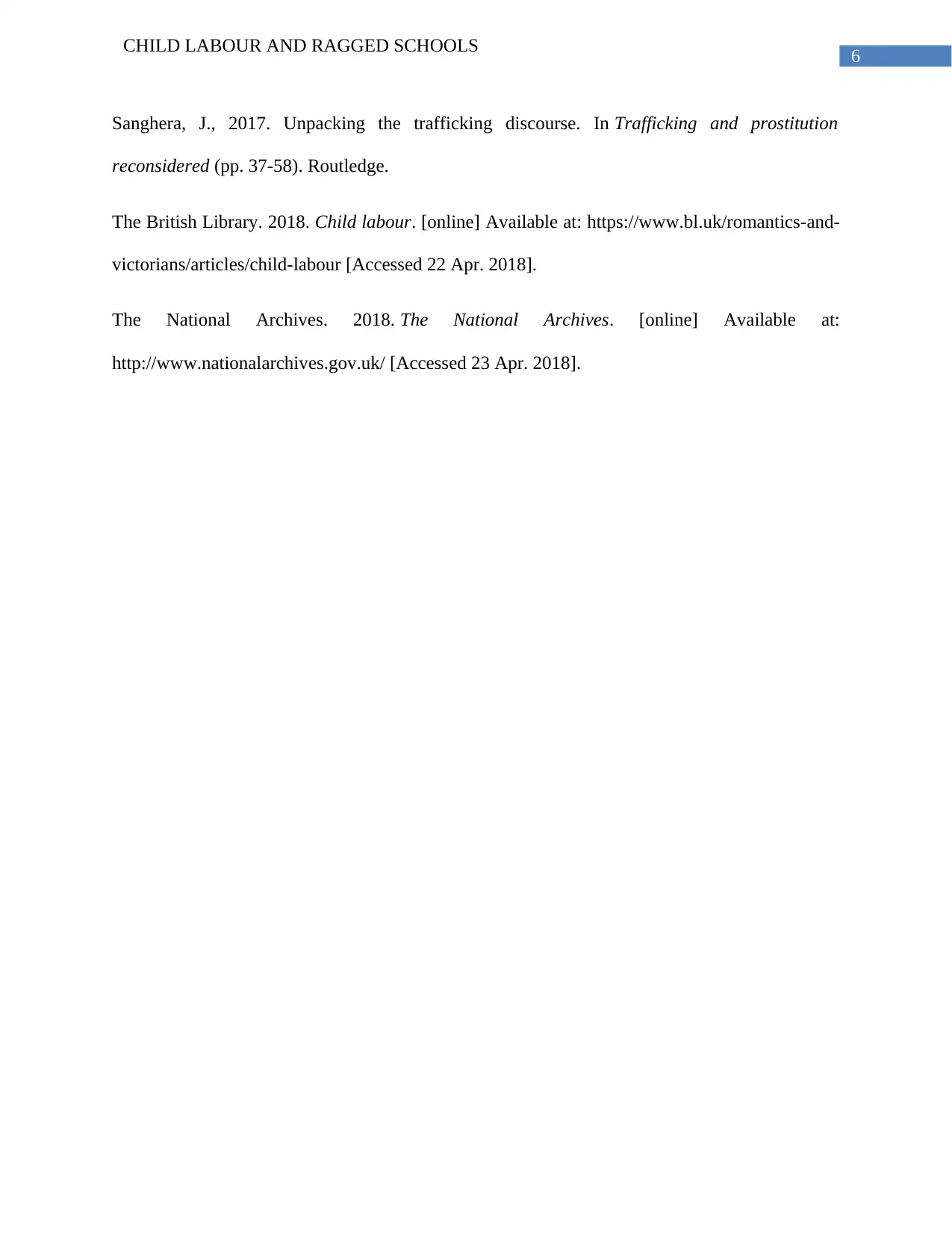
6
CHILD LABOUR AND RAGGED SCHOOLS
Sanghera, J., 2017. Unpacking the trafficking discourse. In Trafficking and prostitution
reconsidered (pp. 37-58). Routledge.
The British Library. 2018. Child labour. [online] Available at: https://www.bl.uk/romantics-and-
victorians/articles/child-labour [Accessed 22 Apr. 2018].
The National Archives. 2018. The National Archives. [online] Available at:
http://www.nationalarchives.gov.uk/ [Accessed 23 Apr. 2018].
CHILD LABOUR AND RAGGED SCHOOLS
Sanghera, J., 2017. Unpacking the trafficking discourse. In Trafficking and prostitution
reconsidered (pp. 37-58). Routledge.
The British Library. 2018. Child labour. [online] Available at: https://www.bl.uk/romantics-and-
victorians/articles/child-labour [Accessed 22 Apr. 2018].
The National Archives. 2018. The National Archives. [online] Available at:
http://www.nationalarchives.gov.uk/ [Accessed 23 Apr. 2018].
Paraphrase This Document
Need a fresh take? Get an instant paraphrase of this document with our AI Paraphraser
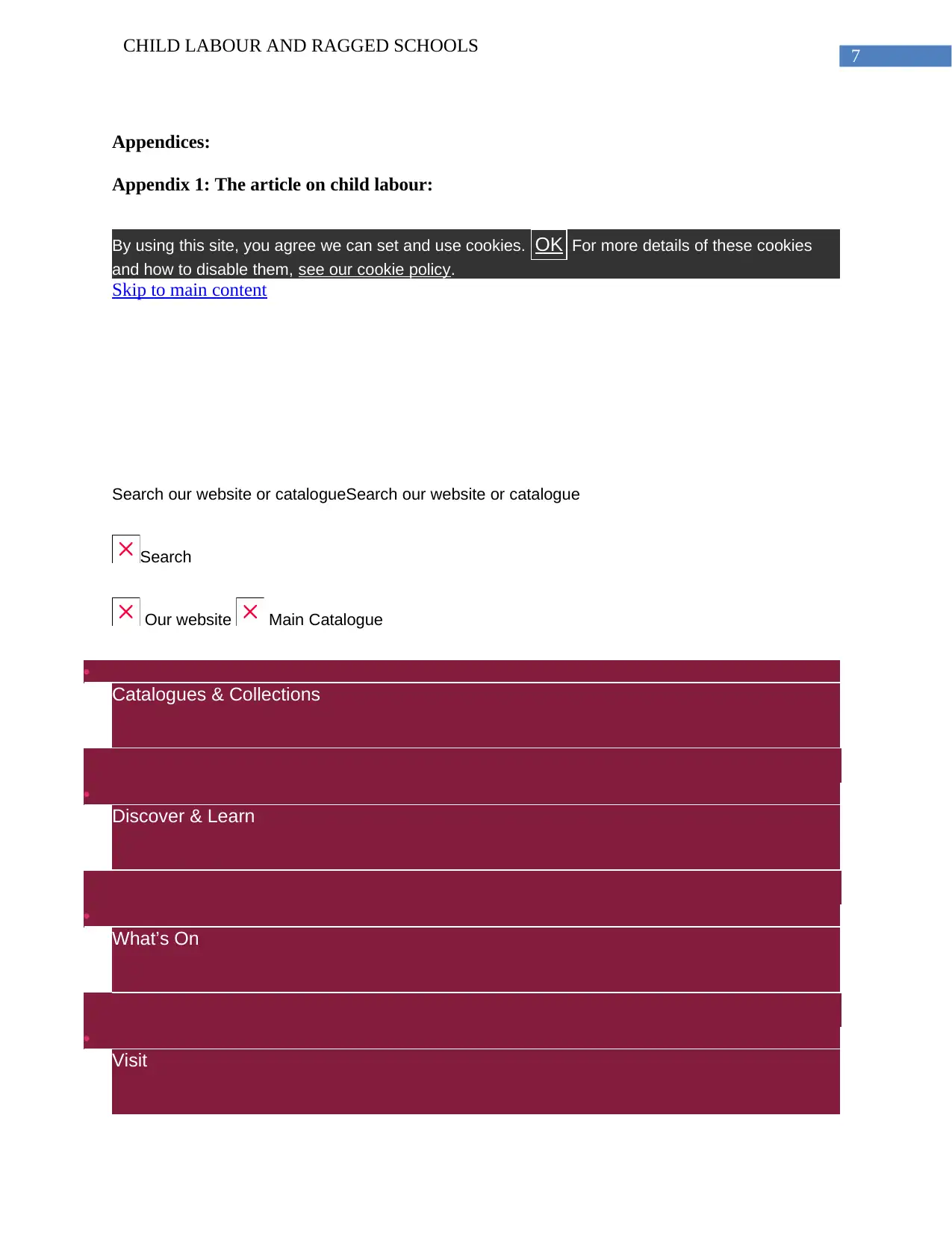
7
CHILD LABOUR AND RAGGED SCHOOLS
Appendices:
Appendix 1: The article on child labour:
By using this site, you agree we can set and use cookies. OK For more details of these cookies
and how to disable them, see our cookie policy.
Skip to main content
Search our website or catalogueSearch our website or catalogue
Search
Our website Main Catalogue
Catalogues & Collections
Discover & Learn
What’s On
Visit
CHILD LABOUR AND RAGGED SCHOOLS
Appendices:
Appendix 1: The article on child labour:
By using this site, you agree we can set and use cookies. OK For more details of these cookies
and how to disable them, see our cookie policy.
Skip to main content
Search our website or catalogueSearch our website or catalogue
Search
Our website Main Catalogue
Catalogues & Collections
Discover & Learn
What’s On
Visit
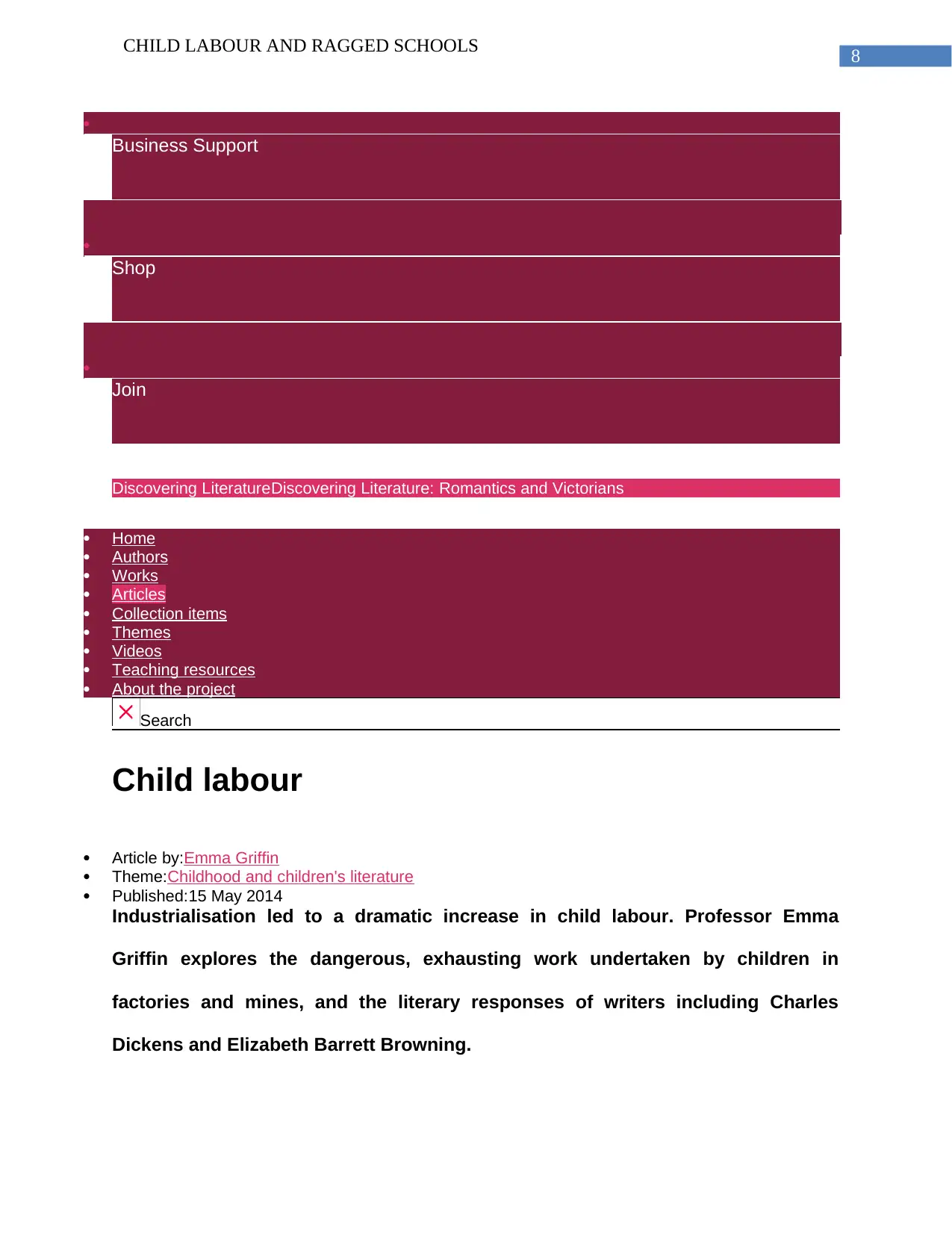
8
CHILD LABOUR AND RAGGED SCHOOLS
Business Support
Shop
Join
Discovering LiteratureDiscovering Literature: Romantics and Victorians
Home
Authors
Works
Articles
Collection items
Themes
Videos
Teaching resources
About the project
Search
Child labour
Article by:Emma Griffin
Theme:Childhood and children's literature
Published:15 May 2014
Industrialisation led to a dramatic increase in child labour. Professor Emma
Griffin explores the dangerous, exhausting work undertaken by children in
factories and mines, and the literary responses of writers including Charles
Dickens and Elizabeth Barrett Browning.
CHILD LABOUR AND RAGGED SCHOOLS
Business Support
Shop
Join
Discovering LiteratureDiscovering Literature: Romantics and Victorians
Home
Authors
Works
Articles
Collection items
Themes
Videos
Teaching resources
About the project
Search
Child labour
Article by:Emma Griffin
Theme:Childhood and children's literature
Published:15 May 2014
Industrialisation led to a dramatic increase in child labour. Professor Emma
Griffin explores the dangerous, exhausting work undertaken by children in
factories and mines, and the literary responses of writers including Charles
Dickens and Elizabeth Barrett Browning.
⊘ This is a preview!⊘
Do you want full access?
Subscribe today to unlock all pages.

Trusted by 1+ million students worldwide
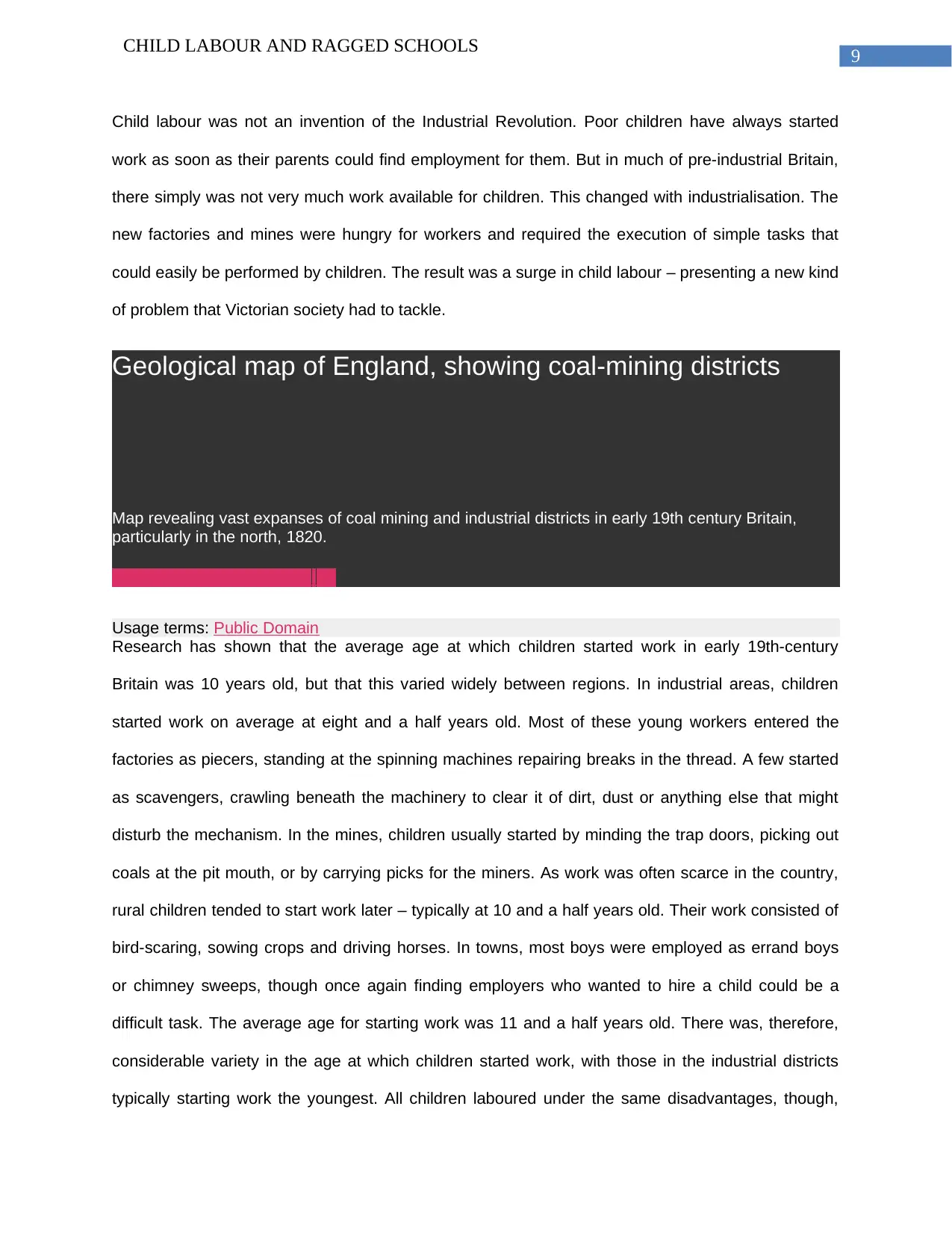
9
CHILD LABOUR AND RAGGED SCHOOLS
Child labour was not an invention of the Industrial Revolution. Poor children have always started
work as soon as their parents could find employment for them. But in much of pre-industrial Britain,
there simply was not very much work available for children. This changed with industrialisation. The
new factories and mines were hungry for workers and required the execution of simple tasks that
could easily be performed by children. The result was a surge in child labour – presenting a new kind
of problem that Victorian society had to tackle.
Geological map of England, showing coal-mining districts
Map revealing vast expanses of coal mining and industrial districts in early 19th century Britain,
particularly in the north, 1820.
View images from this item (1)
Usage terms: Public Domain
Research has shown that the average age at which children started work in early 19th-century
Britain was 10 years old, but that this varied widely between regions. In industrial areas, children
started work on average at eight and a half years old. Most of these young workers entered the
factories as piecers, standing at the spinning machines repairing breaks in the thread. A few started
as scavengers, crawling beneath the machinery to clear it of dirt, dust or anything else that might
disturb the mechanism. In the mines, children usually started by minding the trap doors, picking out
coals at the pit mouth, or by carrying picks for the miners. As work was often scarce in the country,
rural children tended to start work later – typically at 10 and a half years old. Their work consisted of
bird-scaring, sowing crops and driving horses. In towns, most boys were employed as errand boys
or chimney sweeps, though once again finding employers who wanted to hire a child could be a
difficult task. The average age for starting work was 11 and a half years old. There was, therefore,
considerable variety in the age at which children started work, with those in the industrial districts
typically starting work the youngest. All children laboured under the same disadvantages, though,
CHILD LABOUR AND RAGGED SCHOOLS
Child labour was not an invention of the Industrial Revolution. Poor children have always started
work as soon as their parents could find employment for them. But in much of pre-industrial Britain,
there simply was not very much work available for children. This changed with industrialisation. The
new factories and mines were hungry for workers and required the execution of simple tasks that
could easily be performed by children. The result was a surge in child labour – presenting a new kind
of problem that Victorian society had to tackle.
Geological map of England, showing coal-mining districts
Map revealing vast expanses of coal mining and industrial districts in early 19th century Britain,
particularly in the north, 1820.
View images from this item (1)
Usage terms: Public Domain
Research has shown that the average age at which children started work in early 19th-century
Britain was 10 years old, but that this varied widely between regions. In industrial areas, children
started work on average at eight and a half years old. Most of these young workers entered the
factories as piecers, standing at the spinning machines repairing breaks in the thread. A few started
as scavengers, crawling beneath the machinery to clear it of dirt, dust or anything else that might
disturb the mechanism. In the mines, children usually started by minding the trap doors, picking out
coals at the pit mouth, or by carrying picks for the miners. As work was often scarce in the country,
rural children tended to start work later – typically at 10 and a half years old. Their work consisted of
bird-scaring, sowing crops and driving horses. In towns, most boys were employed as errand boys
or chimney sweeps, though once again finding employers who wanted to hire a child could be a
difficult task. The average age for starting work was 11 and a half years old. There was, therefore,
considerable variety in the age at which children started work, with those in the industrial districts
typically starting work the youngest. All children laboured under the same disadvantages, though,
Paraphrase This Document
Need a fresh take? Get an instant paraphrase of this document with our AI Paraphraser
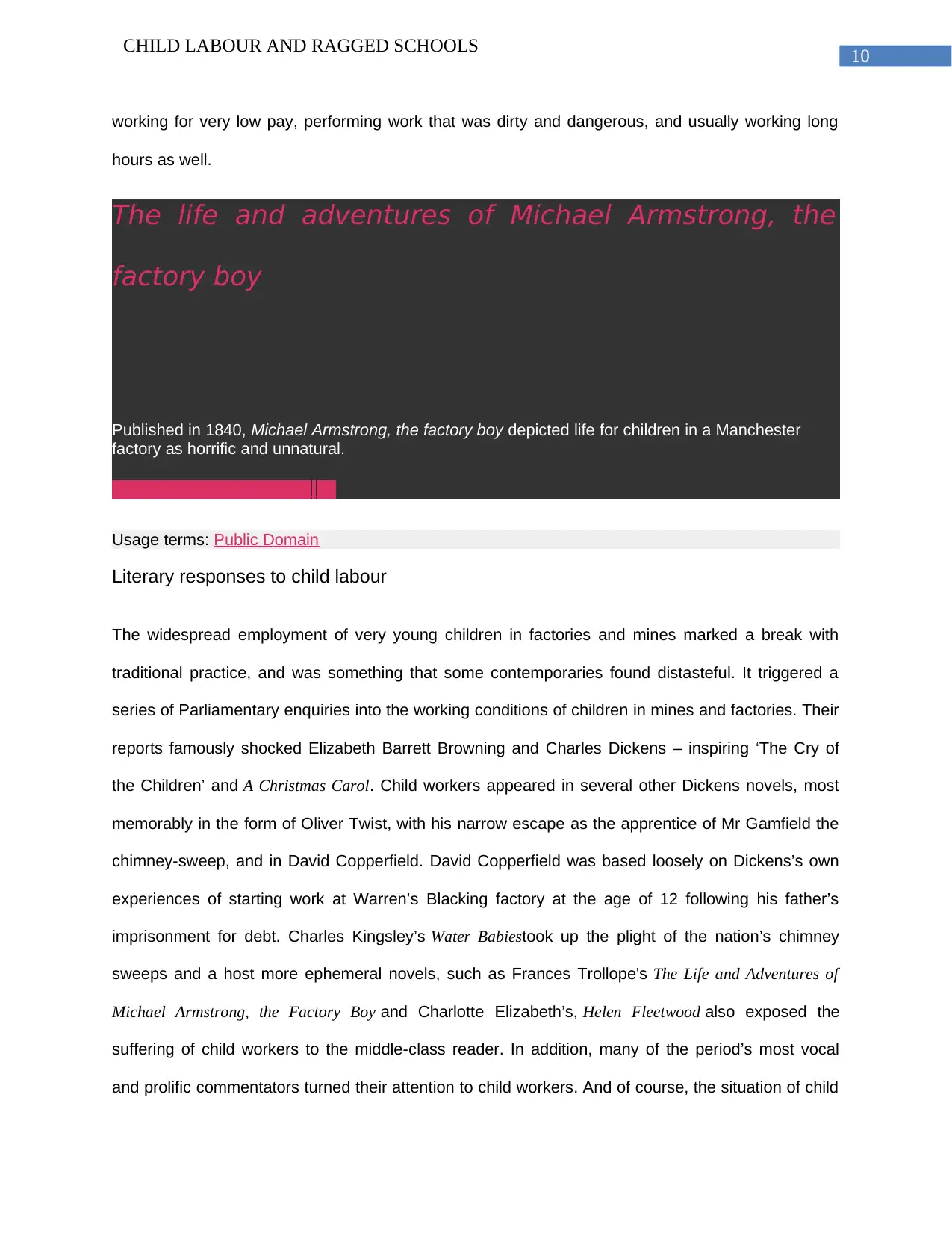
10
CHILD LABOUR AND RAGGED SCHOOLS
working for very low pay, performing work that was dirty and dangerous, and usually working long
hours as well.
The life and adventures of Michael Armstrong, the
factory boy
Published in 1840, Michael Armstrong, the factory boy depicted life for children in a Manchester
factory as horrific and unnatural.
View images from this item (2)
Usage terms: Public Domain
Literary responses to child labour
The widespread employment of very young children in factories and mines marked a break with
traditional practice, and was something that some contemporaries found distasteful. It triggered a
series of Parliamentary enquiries into the working conditions of children in mines and factories. Their
reports famously shocked Elizabeth Barrett Browning and Charles Dickens – inspiring ‘The Cry of
the Children’ and A Christmas Carol. Child workers appeared in several other Dickens novels, most
memorably in the form of Oliver Twist, with his narrow escape as the apprentice of Mr Gamfield the
chimney-sweep, and in David Copperfield. David Copperfield was based loosely on Dickens’s own
experiences of starting work at Warren’s Blacking factory at the age of 12 following his father’s
imprisonment for debt. Charles Kingsley’s Water Babiestook up the plight of the nation’s chimney
sweeps and a host more ephemeral novels, such as Frances Trollope's The Life and Adventures of
Michael Armstrong, the Factory Boy and Charlotte Elizabeth’s, Helen Fleetwood also exposed the
suffering of child workers to the middle-class reader. In addition, many of the period’s most vocal
and prolific commentators turned their attention to child workers. And of course, the situation of child
CHILD LABOUR AND RAGGED SCHOOLS
working for very low pay, performing work that was dirty and dangerous, and usually working long
hours as well.
The life and adventures of Michael Armstrong, the
factory boy
Published in 1840, Michael Armstrong, the factory boy depicted life for children in a Manchester
factory as horrific and unnatural.
View images from this item (2)
Usage terms: Public Domain
Literary responses to child labour
The widespread employment of very young children in factories and mines marked a break with
traditional practice, and was something that some contemporaries found distasteful. It triggered a
series of Parliamentary enquiries into the working conditions of children in mines and factories. Their
reports famously shocked Elizabeth Barrett Browning and Charles Dickens – inspiring ‘The Cry of
the Children’ and A Christmas Carol. Child workers appeared in several other Dickens novels, most
memorably in the form of Oliver Twist, with his narrow escape as the apprentice of Mr Gamfield the
chimney-sweep, and in David Copperfield. David Copperfield was based loosely on Dickens’s own
experiences of starting work at Warren’s Blacking factory at the age of 12 following his father’s
imprisonment for debt. Charles Kingsley’s Water Babiestook up the plight of the nation’s chimney
sweeps and a host more ephemeral novels, such as Frances Trollope's The Life and Adventures of
Michael Armstrong, the Factory Boy and Charlotte Elizabeth’s, Helen Fleetwood also exposed the
suffering of child workers to the middle-class reader. In addition, many of the period’s most vocal
and prolific commentators turned their attention to child workers. And of course, the situation of child
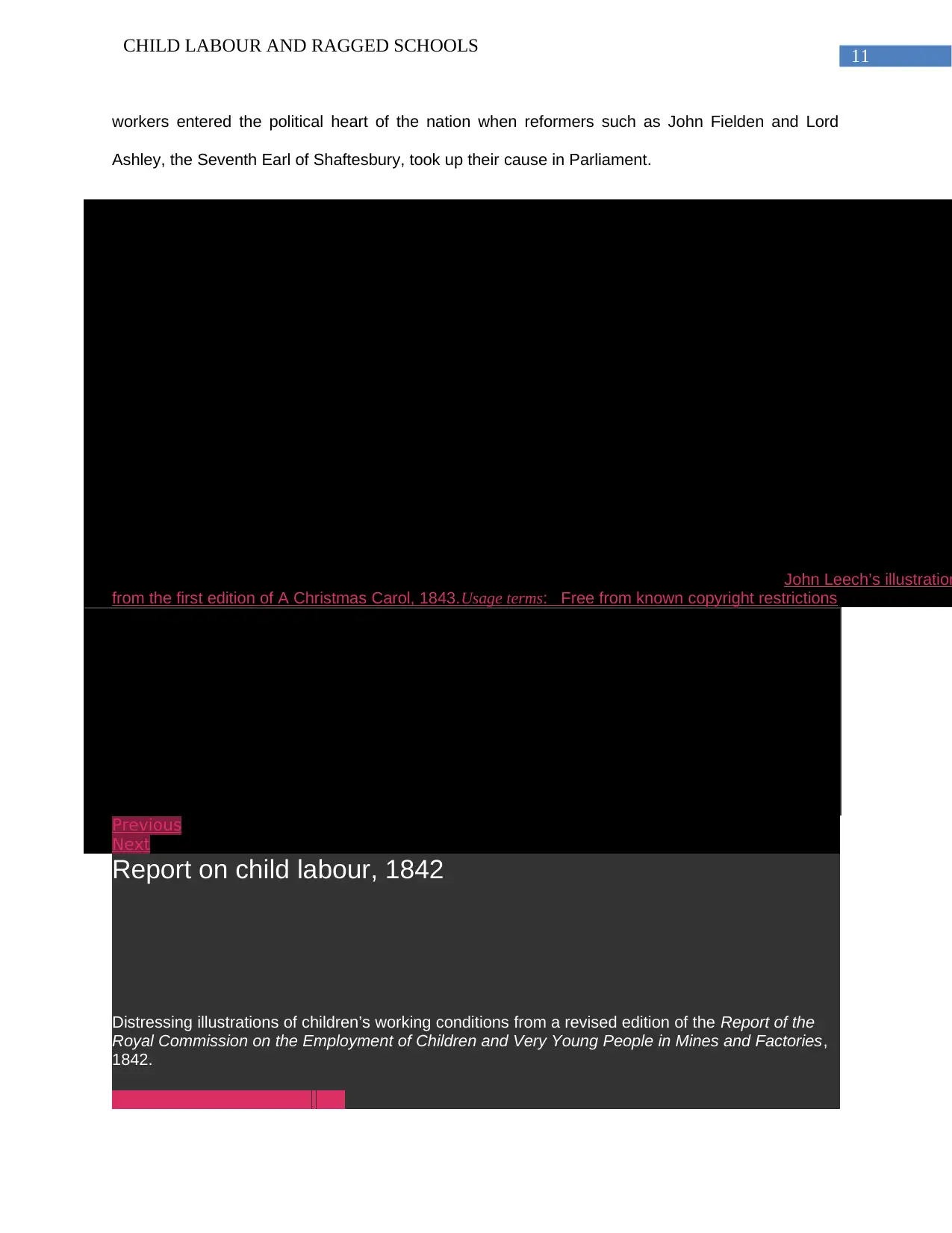
11
CHILD LABOUR AND RAGGED SCHOOLS
workers entered the political heart of the nation when reformers such as John Fielden and Lord
Ashley, the Seventh Earl of Shaftesbury, took up their cause in Parliament.
John Leech’s illustration
from the first edition of A Christmas Carol, 1843.Usage terms: Free from known copyright restrictions
1.
2.
3.
4.
5.
Previous
Next
Report on child labour, 1842
Distressing illustrations of children’s working conditions from a revised edition of the Report of the
Royal Commission on the Employment of Children and Very Young People in Mines and Factories,
1842.
View images from this item (12)
CHILD LABOUR AND RAGGED SCHOOLS
workers entered the political heart of the nation when reformers such as John Fielden and Lord
Ashley, the Seventh Earl of Shaftesbury, took up their cause in Parliament.
John Leech’s illustration
from the first edition of A Christmas Carol, 1843.Usage terms: Free from known copyright restrictions
1.
2.
3.
4.
5.
Previous
Next
Report on child labour, 1842
Distressing illustrations of children’s working conditions from a revised edition of the Report of the
Royal Commission on the Employment of Children and Very Young People in Mines and Factories,
1842.
View images from this item (12)
⊘ This is a preview!⊘
Do you want full access?
Subscribe today to unlock all pages.

Trusted by 1+ million students worldwide
1 out of 78
Your All-in-One AI-Powered Toolkit for Academic Success.
+13062052269
info@desklib.com
Available 24*7 on WhatsApp / Email
![[object Object]](/_next/static/media/star-bottom.7253800d.svg)
Unlock your academic potential
Copyright © 2020–2025 A2Z Services. All Rights Reserved. Developed and managed by ZUCOL.

